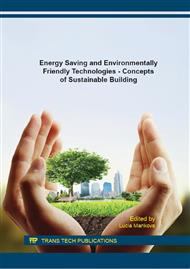p.563
p.571
p.579
p.589
p.598
p.606
p.614
p.625
p.633
Simulation and Measurement of Hygrothermal Behaviour of Newly Developed Plasters
Abstract:
Recently, there has been increased interest in the rehabilitation of existing buildings especially in order to improve their energy performance. Thermal insulation brings not only savings in the cost of heating or cooling but also contributes to the reduction of harmful emissions such as carbon dioxide, sulphur dioxide or nitrogen dioxide. However, the thermal insulation of historical buildings or buildings listed as cultural heritage brings some problems due to architectural features. It is therefore necessary to choose an alternative whether it is the use of an internal thermal insulation system or to repair and rehabilitate the existing plaster with materials compatible with the original ones. The newly developed thermal insulation plasters based on silicate and using lightweight aggregate and natural fibres are optimum materials for the thermal insulation of both existing and newly constructed buildings. The paper describes the results of research focused on the examination of the behaviour of thermal insulation plaster mainly in terms of heat and moisture transport. Using a computational programme, this behaviour was simulated for a chosen detail of a real building in the vicinity of a window jamb.
Info:
Periodical:
Pages:
598-605
Citation:
Online since:
January 2016
Authors:
Price:
Сopyright:
© 2016 Trans Tech Publications Ltd. All Rights Reserved
Share:
Citation:



